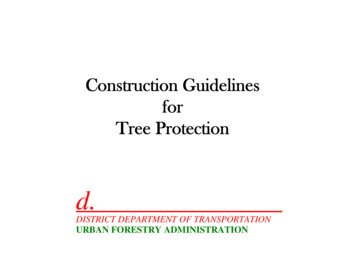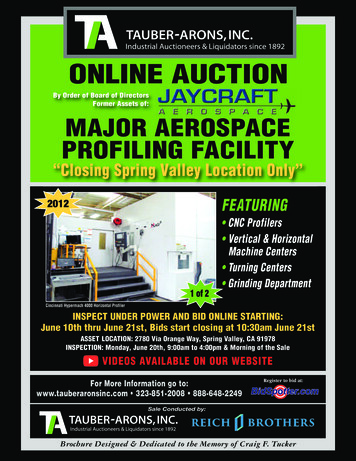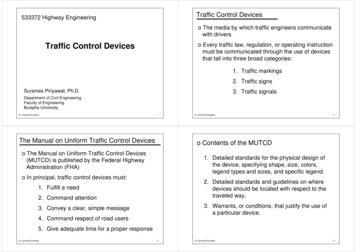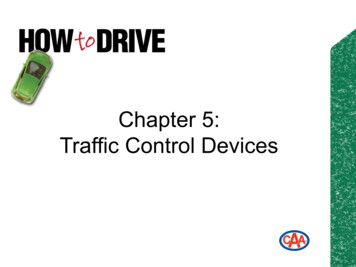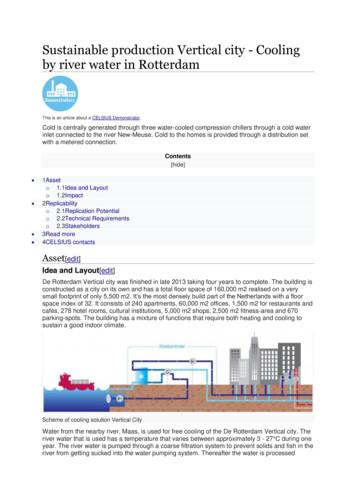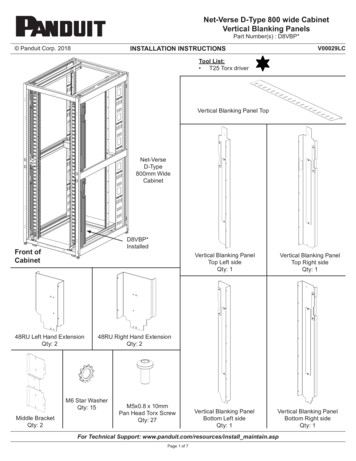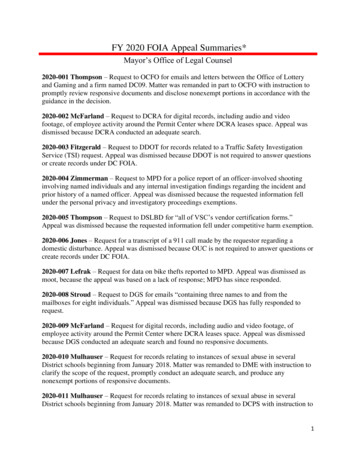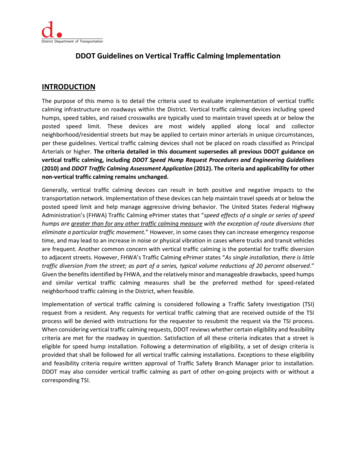
Transcription
DDOT Guidelines on Vertical Traffic Calming ImplementationINTRODUCTIONThe purpose of this memo is to detail the criteria used to evaluate implementation of vertical trafficcalming infrastructure on roadways within the District. Vertical traffic calming devices including speedhumps, speed tables, and raised crosswalks are typically used to maintain travel speeds at or below theposted speed limit. These devices are most widely applied along local and collectorneighborhood/residential streets but may be applied to certain minor arterials in unique circumstances,per these guidelines. Vertical traffic calming devices shall not be placed on roads classified as PrincipalArterials or higher. The criteria detailed in this document supersedes all previous DDOT guidance onvertical traffic calming, including DDOT Speed Hump Request Procedures and Engineering Guidelines(2010) and DDOT Traffic Calming Assessment Application (2012). The criteria and applicability for othernon-vertical traffic calming remains unchanged.Generally, vertical traffic calming devices can result in both positive and negative impacts to thetransportation network. Implementation of these devices can help maintain travel speeds at or below theposted speed limit and help manage aggressive driving behavior. The United States Federal HighwayAdministration’s (FHWA) Traffic Calming ePrimer states that “speed effects of a single or series of speedhumps are greater than for any other traffic calming measure with the exception of route diversions thateliminate a particular traffic movement.” However, in some cases they can increase emergency responsetime, and may lead to an increase in noise or physical vibration in cases where trucks and transit vehiclesare frequent. Another common concern with vertical traffic calming is the potential for traffic diversionto adjacent streets. However, FHWA’s Traffic Calming ePrimer states “As single installation, there is littletraffic diversion from the street; as part of a series, typical volume reductions of 20 percent observed.”Given the benefits identified by FHWA, and the relatively minor and manageable drawbacks, speed humpsand similar vertical traffic calming measures shall be the preferred method for speed-relatedneighborhood traffic calming in the District, when feasible.Implementation of vertical traffic calming is considered following a Traffic Safety Investigation (TSI)request from a resident. Any requests for vertical traffic calming that are received outside of the TSIprocess will be denied with instructions for the requester to resubmit the request via the TSI process.When considering vertical traffic calming requests, DDOT reviews whether certain eligibility and feasibilitycriteria are met for the roadway in question. Satisfaction of all these criteria indicates that a street iseligible for speed hump installation. Following a determination of eligibility, a set of design criteria isprovided that shall be followed for all vertical traffic calming installations. Exceptions to these eligibilityand feasibility criteria require written approval of Traffic Safety Branch Manager prior to installation.DDOT may also consider vertical traffic calming as part of other on-going projects with or without acorresponding TSI.
June 2, 2022Page 2 of 5ELIGBILITY CRITERIAThe following criteria must be met for a street to be eligible for vertical traffic calming installation.Roadway Classification, Traffic Volume and SpeedLocal RoadsSpeed humps and/or raised crosswalks may be installed on streets classified as local roads withpredominantly residential land uses, provided that all other eligibility and design criteria are met.While DDOT may choose to collect traffic data on a case-by-case basis, it is not a requirement forimplementation of vertical traffic calming devices on local roads.Collector RoadsInstallation of speed tables and/or raised crosswalks on collectors with ADT (Average Daily Traffic)less than 5,000 vehicles per day can be considered following the collection of volume and speed data.Speed data should be evaluated in the context of Vision Zero based on the known dangers of increasedtravel speeds on safety, and particularly the safety of vulnerable users as the risk of fatality or seriousinjury increases exponentially with vehicle travel speed. Engineering judgement shall govern the finaldecision in all cases.Installation of raised crosswalks can be considered on collectors with ADT between 5,000 and 7,500vehicles per day in unique circumstances following an engineering assessment. Vertical traffic calmingdevices shall not be installed on collectors with ADT higher than 7,500 vehicles per day.Other ClassificationsIn general, for speed management on minor arterials or roads with higher classifications, alternativecountermeasures such as Automated Traffic Enforcement (ATE), Driver Feedback Signs (DFB), flashingspeed limit signs, as well as corridor-level treatments including road diet projects are preferred andshould be considered before vertical traffic calming. Additional proven traffic control devices tospecifically address pedestrian crossing safety issues on arterial that can be considered include butare not limited to flashing pedestrian signs, Rectangular Rapid Flashing Beacons (RRFB), anddepending on deployment criteria and availability of funding and resources, High-Intensity ActivatedCrossWalK (HAWK).Vertical traffic calming devices shall not be placed on roads classified as minor arterials with ADThigher than 7,500 vehicles per day or on higher classification roads. Speed tables and/or raisedcrosswalks may be considered on minor arterials with ADT lower than 5,000 vehicles per day,following an engineering assessment. Additionally, installation of raised crosswalks can be consideredon minor arterials with ADT between 5,000 and 7,500 vehicles per day in unique circumstancesfollowing an engineering assessment with special considerations given to proximity to schools andhigher concentration of vulnerable road users at uncontrolled crossings along these arterials.
June 2, 2022Page 3 of 5The functional classification of streets in the District can be found in the 2016 Functional tionalClass 2016.pdfThe approximate ADT of streets in the District can be found in the 2018 Traffic Volume es/ddot/publication/attachments/TrafficVolumes 2018.pdfRoadway GradeVertical traffic calming shall not be installed on roadways where the grade exceeds eight percent (8%).Roadway grade can be determined by field survey when collecting existing site conditions or can beestimated using Google Earth. If grades measured using Google Earth are within one percent (1%) ofthis threshold, a field survey using an inclinometer shall be performed to confirm the roadway grade.Roadway Speed LimitVertical traffic calming shall not be installed on roads where the posted speed limit is greater than 30miles per hour. Where no speed limit is posted and on all local roads, the default speed limit isassumed to be 20 miles per hour.Emergency Access RouteVertical traffic calming shall not be installed on any roadway that serves as a primary route foremergency vehicles, such as the main approaches to hospitals or fire stations.Truck or Transit RouteSpeed humps shall not be installed on streets that are designated as transit or truck routes.Consideration should be given to installation of speed tables and/or raised crosswalks if vertical trafficcalming is desired on such roadways, if heavy vehicle (i.e., trucks and buses) percentage does notexceed 5%. Determination of heavy vehicle percentage along higher-volume collectors should bemade based on vehicle classification counts.A map of WMATA transit routes can be found EB WMA MAG DC 21x34 210305.pdfA map of DDOT-designated truck routes can be found tes/ddot/service content/attachments/DC%20Truck%20Map%20Brochure 12.10.20 web.pdf
June 2, 2022Page 4 of 5DESIGN CRITERIAIf a street is found to be eligible for vertical traffic calming installation, the following design specificationsshould be used to determine the exact location of vertical traffic calming devices in the field. Devices shall be placed in locations where drivers have adequate sight distance to see verticaldeflection on the roadway surface, preferably from a distance of at least 250 feet onuninterrupted segments of road for drivers traveling at the design speed;Placement of devices must avoid conflicts with other transportation and utility infrastructure;Devices should be located near a streetlight to ensure nighttime illumination;Devices shall be installed at least 200 feet apart but not greater than 500 feet apart on roadsegments bounded by two intersections;Devices shall be placed at least 5 feet from a driveway, and 20 feet from an alley;Devices should be placed at least 150' from STOP or YIELD-controlled intersection approaches.However, where other constraints exist (e.g., short block spacing or presence of driveways) adistance of at least 100' may be used provided that proper spacing and placement of warningsigns can be maintained;Devices should be placed at least 250’ from a traffic signal (shorter spacing may be considered ona case-by-case basis);Devices should NOT be installed on horizontal or vertical curves if avoidable. If placement on acurve is unavoidable, advanced warning signs and markings shall be designed to providesatisfactory notice to drivers;Devices shall NOT be installed in the path of a pedestrian crossing or curb ramp, unless the deviceinstalled is a raised crosswalk;Devices shall NOT be installed over manholes or water valves;Devices shall NOT be installed adjacent to fire hydrants;Devices installed near drainage inlets should be installed on the downslope side of the inlet as tonot impact drainage flow; andDevices may be installed on concrete roadways using either asphalt or concrete construction.If it is determined during design that one or more of the above criteria would be violated, the Traffic SafetyBranch Manager shall make a final determination on whether it is still feasible and safe to install verticaltraffic calming devices and where the devices shall be installed. Locations of vertical traffic calming devicesproposed under a Safe Routes to School assessment shall comply with all design criteria.Raised CrosswalksAdditional design criteria are required for the installation of raised crosswalks, as outlined below.Raised crosswalks installed at an intersection shall require a full engineering design plan that isdesigned by a licensed professional engineer. Raised Crosswalks, including their flares or pitch, should not be installed in conflict with water,sewer, gas, telecom, Pepco, or DDOT-owned signal/streetlight manholes;Raised Crosswalks shall not be installed such that the flares extend into any conflicting travel laneswhen installed at intersections;
June 2, 2022Page 5 of 5 Raised Crosswalks shall not be installed at intersections such that any relocation of the stop barthat may be required to install the raised crosswalk violates minimum intersection sight distances.Raised crosswalks are most preferred at uncontrolled and/or midblock crossings, where vehiculartraffic flow is not controlled by a traffic control device such as a stop sign or a traffic light;Raised Crosswalks shall not be installed if proper alignment of ADA ramps with the proposedcrosswalk cannot be maintained; andRaised Crosswalks shall not be installed such that they will impact drainage flow.EXCEPTIONSAny exceptions to the guidelines outlined in this document shall require written approval from the TrafficSafety Branch Manager of the Traffic Engineering and Safety Division.DESIGN STANDARDSDesign specifications for vertical traffic calming devices and the associated warning signs, as installed byDDOT, are provided in the following sections.Speed Hump Design Specifications*WARNING SIGNS SHALL BE REPEATED ONBOTH SIDES OF THE ROAD FOR ONE-WAYSTREETS OR REPEATED IN THE OPPOSITEDIRECTION OF TRAVEL FOR TWO-WAYSTREETS. ADVANCE WARNING SIGNS ARERECEOMMENDED AND SHOULD BE INSTALLEDIF ROADWAY CONDITIONS ALLOW.**SPEED HUMPS MAY BECONSTRUCTED ON CONCRETEROADWAY USING ASPHALT ORCONCRETENOTES:TYPICALLY, A SPEED HUMP IS 14 FEET LONG BUT CAN BE BETWEEN 10 FEET AND 14 FEET IN LENGTH, AND HIEGHT CAN BE BETWEEN 3 INCHES AND 4INCHES. TYPICAL HEIGHT IS 4 INCHES.
June 2, 2022Page 6 of 5Speed Table Design Specifications*WARNING SIGNS SHALL BE REPEATED ONBOTH SIDES OF THE ROAD FOR ONE-WAYSTREETS OR REPEATED IN THE OPPOSITEDIRECTION OF TRAVEL FOR TWO-WAYSTREETS. ADVANCE WARNING SIGNS ARERECEOMMENDED AND SHOULD BE INSTALLEDIF ROADWAY CONDITIONS ALLOW.**SPEED TABLES MAY BECONSTRUCTED ON CONCRETEROADWAY USING ASPHALT ORCONCRETENOTES:TYPICALLY, A SPEED TABLE IS 27 FEET LONG BUT CAN BE BETWEEN 22 FEET AND 27FEET IN LENGTH. HIEGHT CAN BE BETWEEN 3 INCHES AND 4 INCHES.TYPICAL HEIGHT IS 4 INCHES.
June 2, 2022Page 7 of 5Raised Crosswalk Design Specifications*WARNING SIGNS SHALL BE REPEATED ONBOTH SIDES OF THE ROAD FOR ONE-WAYSTREETS OR REPEATED IN THE OPPOSITEDIRECTION OF TRAVEL FOR TWO-WAYSTREETS. ADVANCE WARNING SIGNS ARERECEOMMENDED AND SHOULD BE INSTALLEDIF ROADWAYCONDITIONS ALLOW.**RAISED CROSSWALKS MAY BECONSTRUCTED ON CONCRETEROADWAY USING ASPHALT ORCONCRETENOTES:1. THE WIDTH FOR RAISED CROSSWALKS WILL BE 22 FEET FOR LOCAL ROADS AND 27 FEET FOR COLLECTOR ROADS. HIEGHT CAN BE BETWEEN 3 INCHES AND4 INCHES. TYPICAL HEIGHT IS 4 INCHES.2. IF INSTALLATION OF PERPENDICULAR RAMP IS NOT FEASIBLE THEN REFER TO OTHER RAMP DETAILS.
estimated using Google Earth. If grades measured using Google Earth are within one percent (1%) of this threshold, a field survey using an inclinometer shall be performed to confirm the roadway grade. Roadway Speed Limit Vertical traffic calming shall not be installed on roads where the posted speed limit is greater than 30 miles per hour.

